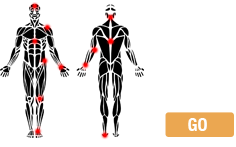What is Physiotherapy?
Physiotherapy is a regulated health care profession trained at evaluating, restoring and maintaining physical function. It is a distinct form of care which can be performed both in isolation or in conjunction with other types of medical management.
Physiotherapy can be useful in the diagnosis and management of a wide variety of injuries, disease processes, and other conditions.
How can physiotherapy help me?
Physiotherapy can help individuals by:
-Identifying the problem area and treating this directly.
Physiotherapists are effective at treating injuries and physical limitations using many variety of techniques. In many cases, the causes of pain and dysfunction are obvious, but sometimes things are not so evident, especially when symptoms are inconsistent or difficult to describe. Physiotherapists can perform a wide range of tests to help locate the source of the problem and implement the appropriate treatment strategy.
– Identifying the Causes and Predisposing Factors.
Physiotherapists are not only interested in the symptoms, but also the factors which contribute to the problem. Identifying factors such as poor posture, improper movement, muscle imbalances, poor work practices, or other bad habits allow interventions to be made more effective helping you recover quicker. This will reduce the risk of the same thing happening again in the future.
– Determine Solutions:
Our physiotherapists use a wide array of treatment techniques and approaches to help you move better or reduce the pain and stiffness you may be experiencing.
These treatments include amongst others:
- Manual (‘Hands On’) Therapy
- Physical/Electro-Therapeutic Agents (e.g. laser, magnetic bio-stimulation, ultrasound, electric current, laser, heat, ice, paraffin wax etc)
- Ergonomic Education/Advice
- Taping Techniques (including Kinesio-taping, postural and sports specific taping)
- Medical Acupuncture
- Exercise Therapy
- Custom Orthotics
- IMS (Intra-Muscular Stimulation)
- Osteopathy
- Pre- and Post-Surgical Physiotherapy
Our Physiotherapist are successful in treating:
- Back and Neck Pain
- Postural Problems
- Occupational Injuries
- Arthritis
- Amputee Rehabilitation
- Spinal Cord Injuries
- Chronic Airways Disease
- Rehabilitation following Surgery
- Stroke Rehabilitation
- Asthma Management
- Specific children’s conditions
- Neurological Conditions
- Impaired Mobility
- Incontinence
- Geriatric Problems
FAQ
What can physiotherapy help with?
Physiotherapy has been shown to be effective in many conditions. Post injury rehabilitation, post surgical rehabilitation, reduction in pain, stiffness, weakness, numbness, tingling, concussions, sports performance and so much more.
Will OHIP pay for physiotherapy?
There are very few physiotherapy services covered by The Ontario Health Insurance Plan (OHIP). Some OHIP clinics still exist and are able to get some funding for children under 18 and seniors over 65. The amount paid is far below market rates and as a result these clinics tend to see more patients per hour and tend to use assistants to maximize care per dollar.
OHIP can also covers the cost of in-clinic physiotherapy services for youth, seniors, and other patients that are recovering from illness, surgery or injury. The number of treatments you can receive is determined by your physiotherapist and is referred to as an Episode of Care.
How can a physiotherapist help with mobility?
A physiotherapist can help mobility using hands on / manual therapy to move joints fascia, muscles and more. They will also stretch and give exercises to assist in mobility.
Do you need a referral for physiotherapy treatments?
No. In Ontario, physiotherapists are considered primary health care practitioners and therefore are able to provide direct care. They have been trained to assess and treat without a referral from a doctor. . However, if you have coverage for physiotherapy treatment through an extended health benefit plan, some insurance companies may require a doctor’s referral for reimbursement. It is best to check with your individual insurer if you are unsure.
Why is an assessment needed by the physiotherapist?
At Physioactive, we do not use any assistants as we believe the precision in which you do your exercises and the refinement and feedback from your physiotherapist is so important. At Physioactive, we only see 2 patients per hour to make sure enough time is available for all our patients. A treatment will usually include manual/hands on therapy, education, exercise, and a modality. Some clinics will use assistants to supervise exercises or allow the physiotherapist to see more patients.
What should I wear to an appointment with the physiotherapist?
We recommend you wear comfortable, loose-fitting clothing that will allow us to easily see the skin, joints and muscles around your injury. Our therapists typically look at the whole body for all injuries and the more of the body we see the better we can evaluate your injury/complaints and contributing factors. Shorts underneath pants and a sports bra or tank top work well for females. Ultimately, patient comfort is the most important, so please wear what you are most comfortable in. This might include lululemon pants instead of shorts or a sports top.
Is physiotherapy appropriate for my injury or condition?
Physiotherapists are regulated health professionals that treat a wide range of conditions.
How many physiotherapy treatments are needed to fix my problem?
The typical patient attends 5-8 treatments. Some patients with very serious injuries or surgeries such as an Achilles tear may require a year of rehabilitation. Our therapist will recommend the optimal treatment plan and estimated amount of visits after your assessment to maximize recover. However, we understand that everyone’s circumstances are different and will work with our patients depending on time and budget.
How long are physiotherapy treatments?
Physiotherapy treatments last between 30 and 60 minutes depending on need. At Physioactive, we only book 2 patients an hour so all our clients are well taken care of.
Physiotherapy assessments are usually 45-60 minutes



